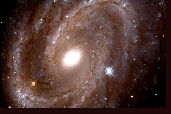A substantial tradition of gathering astronomical data in South
Africa is to be continued with the South African Large Telescope
(SALT).
The Royal Observatory at the Cape of Good Hope was established
in the 1820's. Astronomical work there for many years concentrated
on preparing star catalogues. In 1972 South African observatories
were merged into the South African Astronomical Observatory. The
major telescopes were placed on a hill near Sutherland (pop. 2000)
in the Karoo region of the northern Cape. Also in the 70's' the
South African astronomy effort changed to a focus on the physics
underlying stars and galaxies.
That focus becomes more pronounced with the proposed SALT. It
will be an optical and infrared telescope modeled on the Hobby-Eberly
telescope of the McDonald Observatory in Texas. SALT will conduct
surveys in the spectroscopy of stellar objects. As it is on the
drawing boards, it will be a match for the largest telescope in
the world. It is expected that SALT will be completed in 4 to
5 years. It was completed in 2005.
The length of time needed to complete SALT was the amount of
time John Herschel devoted to observing the Southern sky from
the favorable darkness of the Cape region. He came early on in
the tradition of astronomical excellence. He was at the Cape from
1834-1838 with two telescopes. His larger one was a "sesquipedalian"
of 18 inches in diameter. SALT is 11 yards in effective aperture.
He was based at Feldhausen, SE of Capetown.
During his four years at the Cape, he determined the location
of over 1700 non-stellar objects, many double stars were found,
and many of the mysterious "nebulae", star systems or
not, were observed. Halley's comet came round in 1835. Herschel
observed the comet amidst the studies he was undertaking of the
Magellanic Clouds and of sunspots.
He erected his large telescope on what are now the grounds of
Grove Primary School. An obelisk, built in 1841, marks the spot
where his telescope stood. This obelisk features a tribute to
Herschel. It reads, in part, "contributed as largely by his
benevolent exertions to the cause of education and humanity as
by his eminent talents to the discovery of scientific truth".
In the present day, both a concern for education and scientific
truth fuel the construction and use of SALT. Professor of Physics
Hartmut Winkler at Vista University, Soweto campus, is located
in Johannesburg. Hundreds of miles from him, SALT will join the
other major SA telescopes on the hill.
In a recent email correspondence with Prof. Winkler, I asked
him if he regarded astronomy as an easy way into science. He replied
that astronomy is not always an easy subject, but that it is fascinating
to the public and could be "a useful tool for drawing young
people into the Sciences".
South African children have been cited as placing last in mathematics
and science in a global comparison. Prof. Winkler was asked by
me how this could be so. His reply was succinct - apartheid education.
" Black South Africans were for too long actively discouraged
form studying subjects such as Mathematics and Science".
SALT offers a hope of a scientific revival among the general
population of South Africa. It cannot be a huge locus for tourism
or single-handedly improve the fortunes of the country. Prof.
Winkler, though, believes SALT will mainly be a much-needed stimulant
for arousing interest in science, "which in turn we hope
will boost technological development, and hence benefit the broader
economy".
John Herschel had no such extra burden riding on his telescope.
What would he make of SALT and its educative and economic function?
Can SALT produce "benevolent exertions" in the cause
of education and humanity in South Africa?

